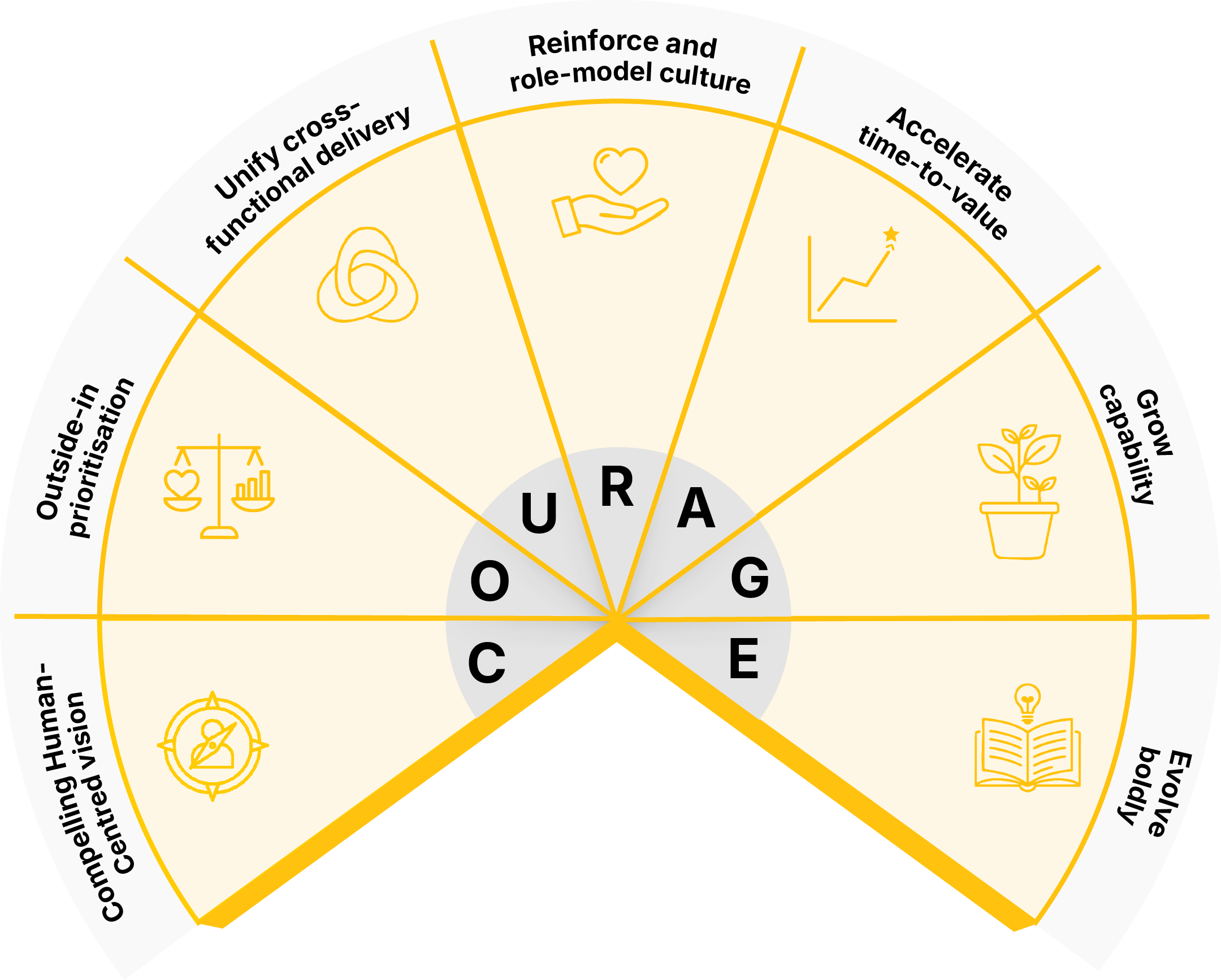What Makes a Leader Successful in Guiding Business Transformation?
To meet rising expectations, transformation leaders need to put people at the heart of their decisions and harness the power of human-centred leadership.

bookmark_star Highlights
- Transformation success now depends on putting people within an organisation's ecosystem - customers, employees, and stakeholders at the centre - not just technology or cost.
- Human-centred leadership requires COURAGE: a set of capabilities that unite vision, culture, delivery, and adaptability.
- The shift is from what organisations transform to who they are transforming for.
Today’s pressures require a different approach to transformation
In today’s current environment, transformation can no longer be approached as a purely structural, technology-led, or cost-driven exercise.
- Expectations of organisations are rising; customers and employees demand transparency, empathy, and want to see genuine value.
- Regulators are sharpening their focus on outcomes that affect people’s lives, particularly in financial services, energy, health, and aged care.
- Economic conditions and cost-of-living pressures mean Australians are making sharper choices about where they spend, who they trust, and who they work for.
Traditional approaches to transformation, such as process or technology-focussed methods, risk missing the mark if they don’t account for the people who use them. A human-centred approach is needed to thrive in these circumstances.
To be clear, this isn't a choice between focusing on people or achieving commercial success – in today's environment, they're inseparable. Organisations with high customer satisfaction scores often have higher employee retention and stronger revenue growth than their peers. The business case for human-centred transformation is that sustainable commercial performance flows from getting the human experience right.
What is human-centred transformation?
Human-centred transformation builds on traditional transformation approaches but amplifies the focus on outcomes for people, whether they be customers, employees or stakeholders. It requires taking a people-first approach to all decision-making and change, and asks leaders to apply additional skills beyond typical leadership skills.
Organisations need to grow leaders who can steer transformation through this human-centred lens. These leaders balance commercial rigour and delivery discipline with a relentless focus on people. They unite stakeholders, create high-value experiences and deliver tangible outcomes for customers, employees and stakeholders.
We call the added capabilities of this style of leadership ‘COURAGE’.
The COURAGE framework for leading through transformation

With over 20 years of experience working with organisations and leaders to drive transformation, we’ve observed what makes leaders successful in driving human-centred transformation. We have distilled this into the seven ‘COURAGE’ capabilities, outlined below.
C - Compelling Human-Centred Vision
Leaders define and communicate a bold, human-centred vision that inspires and unites the organisation. The vision ties business strategy to creating value for customers, employees, and stakeholders.
O - Outside-In Prioritisation
Leaders embed customer and stakeholder value into every decision, ensuring transformation choices are guided by real needs and impact, not internal assumptions. Thinking about transformation from the outside-in prevents costly misallocations of transformation investment and accelerates time-to-value.
U - Unify Cross-Functional Delivery
Leaders break down siloes and create integrated ways of working that deliver seamless customer and employee experiences across departments, partners, and functions.
R - Reinforce and Role-Model Culture
Leaders consistently model and reinforce human-centred mindsets and behaviours, championing people-first values through their daily actions. They cultivate an environment where empathy and customer focus are second-nature to everyone involved.
A - Accelerate Time-to-Value
Leaders deliver tangible results that improve both customer experience and business performance, not just check off milestones. They take a dual-track approach, using short-term wins to build momentum toward larger, strategic shifts.
G - Grow Capability
Leaders build the skills and systems across their teams and organisation that embed human-centred ways of working, reducing reliance on a few individuals.
E - Evolve Boldly
Leaders adapt quickly when evidence shows the plan isn't working. They address problems openly, learn from what's not working, and make tough decisions quickly while staying responsive to what customers and employees are telling them.
Capability guide
The COURAGE Capability Guide goes into detail about what these capabilities look like and common pitfalls for leaders to avoid.
Shifting from a "What" to a "Who" Mindset
The organisations that will truly thrive in this new era are the ones that grow leaders who shift mindsets from what they are transforming to who they are transforming for. This means that now and in the future, leaders will need to think beyond how they redesign processes or implement new technology.
Success lies in the ability to understand, connect with, and elevate the experiences of people: your customers, your employees, and your stakeholders. By embracing human-centred transformational leadership and the principles of COURAGE, you will achieve transformative change while championing people.
Start driving transformation that delivers outcomes for people and performance
Contact us to explore how to strengthen human-centred leadership capabilities within your team.
Get in touch or book a discovery call with our team.
Published
28 October 2025
Written by
Megan Crawford
Lauren Terry
Alana Thomas
Keep reading
Ready to transform your customer experience?
Speak directly with our team of experts to explore your challenges, opportunities and needs.

.png)







